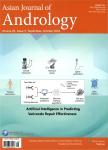The number of spermatozoa collected with testicular sperm extraction is a novel predictor of intracytoplasmic sperm injection outcome in non-obstructive azoospermic patients
The number of spermatozoa collected with testicular sperm extraction is a novel predictor of intracytoplasmic sperm injection outcome in non-obstructive azoospermic patients作者机构:Andros-ltalia Outpatient Clinic of Ferrara 44121 Ferrara Italy Operative Unit of Laboratory of Assisted Reproduction Societe Italiana di Studi di Medicina della Riproduzione(S.I.S.ME.R.) 40138 Bologna Italy Operative Unit of Andrology Societ Italiana di di Studi di Medicina della Riproduzione 40138 Bologna Italy a Operative Unit of AssistedReproduction Societ& Italiana di di Studi di Medicina della Riproduzione 40138 Bologna Italy
出 版 物:《Asian Journal of Andrology》 (亚洲男性学杂志(英文版))
年 卷 期:2011年第13卷第2期
页 面:312-316页
核心收录:
学科分类:090603[农学-临床兽医学] 09[农学] 0906[农学-兽医学]
主 题:conventional TESE ICSI outcomes non-obstructive azoospermia
摘 要:The purpose of this study was to determine the relationships between monitors of spermatogenesis and predictors of the intracytoplasmic sperm injection (ICSI) outcome in patients with non-obstructive azoospermia (NOA) undergoing testicular sperm extraction (TESE). Seventy-nine patients with NOA (mean age: 43.6±5.2 years), each of whom yielded (97 000±3040) spermatozoa with conventional TESE, were considered in our analysis. Their partners (mean age: 35.8±5.1 years) underwent a total of 184 ICSI cycles; 632 oocytes were collected, 221 oocytes were injected, 141 oocytes were fertilized, 121 embryos were obtained, 110 embryos were transferred, 14 clinical pregnancies were achieved and only one miscarriage occurred. Multivariate regression analysis indicated relationships between the percentage of fertilized oocytes, transferred embryos and clinical pregnancies with the following variable values: female partner's age, number of spermatozoa collected, testicular volume, male partner's levels of follicle stimulating hormone (FSH), number of oocytes collected, number of oocytes injected and number of ICSI cycles. A significant inverse relationship was found between female partner's age or male partner's FSH levels and biochemical pregnancies. A significant direct relationship emerged between the number of ICS! cycles and the percentage of oocytes fertilized, embryos transferred and biochemical pregnancies, and between the number of spermatozoa collected per testicular biopsy and biochemical pregnancies. The number of spermatozoa was positively linked to the number of clinical pregnancies, independent of the number of ICSI cycles and the number of oocytes collected/injected. The number of spermatozoa collected, FSH level and testicular volume are monitors of spermatogenesis linked to ICSI success.




